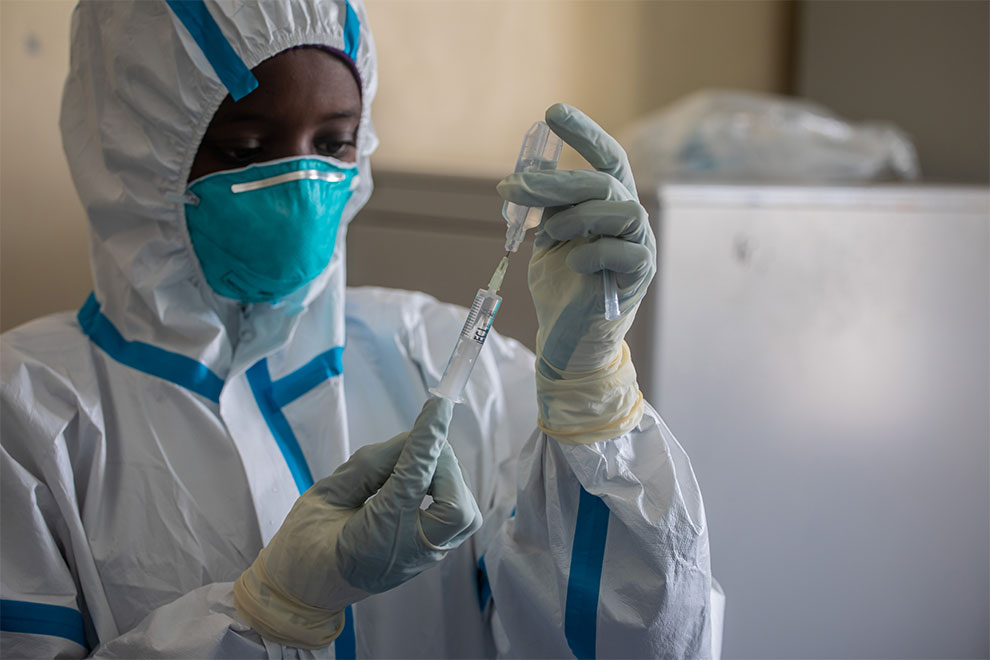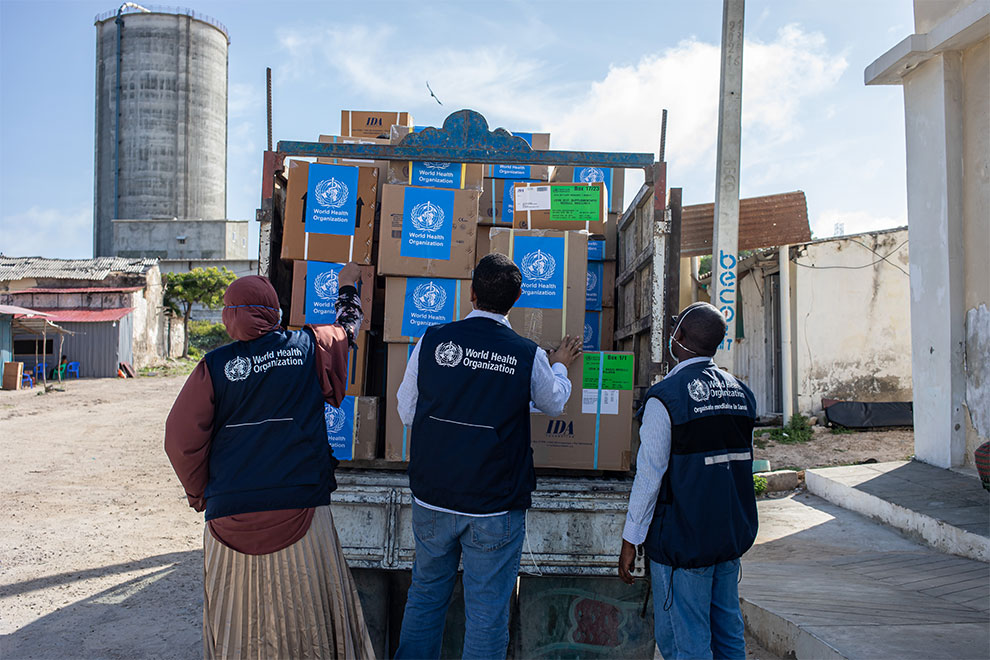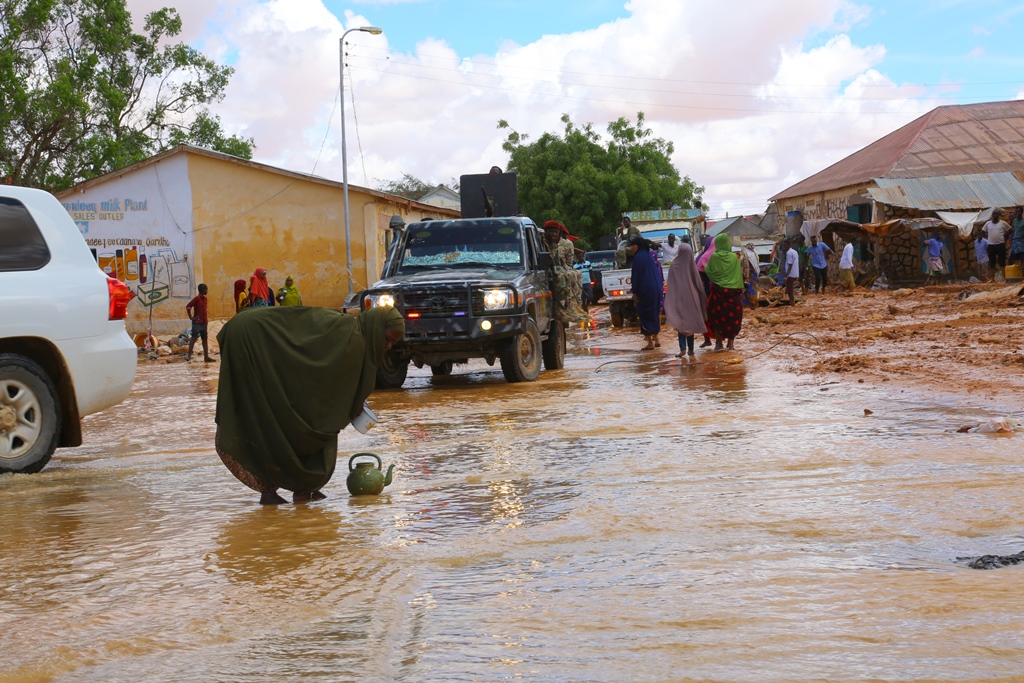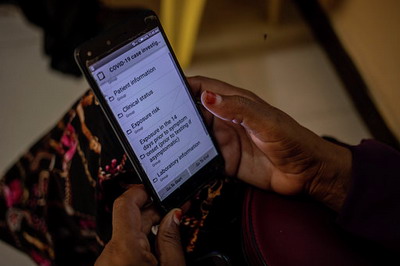EU and WHO unite to deliver critical life-saving supplies to flood-affected areas in Somalia

Mogadishu, 1 June 2020 ‒ The Delegation of the European Union (EU) to Somalia conducted another special flight for WHO in Somalia to airlift lifesaving medicine and other emergency hospital supplies to Jowhar, Kismayo and Baidoa ‒ areas recently affected by flooding caused by heavy rainfall. These WHO emergency medicines and medical supplies will be used for augmenting emergency health care for people affected by the recent floods. Previous EU-operated flights to the flood-affected areas took place on 20‒21 May 2020.
The flights delivered 9144 kgs of supplies of oral rehydration solution, cholera saline and other emergency medicines for patient care, benefiting approximately 2000 individuals over the next 3 months.
Heavy rains are predicted for the remainder of June. The emergency supplies will support emergency health care for cholera and other waterborne diseases for the vulnerable populations of affected areas and also basic health care services in the areas long after the flood water recedes.
“The EU welcomes the opportunity to join forces and resources with WHO in Somalia,” said EU Ambassador to Somalia Nicolas Berlanga. “Somalia faces a confluence of health challenges, including the urgent task of responding to the COVID-19 outbreak. The recent floods that have impacted so much of the country will only complicate that effort. These are complex challenges that require enhanced coordination and rapid response,” the Ambassador added.
Dr Mamunur Rahman Malik, WHO Representative in Somalia, said, “As we continue to fight on all fronts against COVID-19 and now on reducing the health impacts of the floods, I thank the Delegation of the European Union for their generous support in providing the airbridge between the capital city and flood-affected areas for dispatching critical life-saving supplies, especially at a time when these areas are cut off from the rest of the country owing to lockdown and restriction of flights. Our collaboration with the EU will save lives and minimize the health impacts of these catastrophic events. This solidarity remains critical for Somalia besieged by so many health challenges”.
This joint operation is part of a new bilateral coordination mechanism, established between the WHO country office and the Delegation of the EU to Somalia, which aims to strengthen operational response activities, including for COVID-19. On 3 May, EU flights also airlifted critical medical equipment and supplies from Mogadishu to Kismayo to support Jubaland state in tackling COVID-19. In addition, the European Civil Protection and Humanitarian Aid Operations (ECHO) recently provided US$ $1.8 million to WHO’s COVID-19 preparedness and response operations in Somalia.
Effects of flooding
Heavy rains and floods have affected about 918 000 people across Somalia, displacing 412 000 and killing 24 in 29 districts so far. Belet Weyne in Hiraan region is the most affected district after the Shabelle river burst its banks on 12 May and flooded 85% of the town and 25 riverine villages. Jowhar, another agricultural centre, has also been hard hit by flooding. International aid organizations have warned of potential outbreaks of cholera and other waterborne diseases due to overcrowding in areas where those who have been displaced are seeking temporary shelter.
Related link
WHO and EU unite to fight COVID-19 in Somalia
For further information:
Mr Kyle Defreitas
External Relations & Resource Mobilization Officer
World Health Organization, Somalia
Mob: +254-782-501-324
Email:
Ms Fouzia Bhatti
Communication Officer
World Health Organization, Somalia
Tel: +252619235880
Email:
WHO intensifies support to improve case management in Somalia as cases soar

20 May 2020 – Somalia continues its fight against one of the most catastrophic outbreaks the country has ever witnessed. In spite of recurrent humanitarian emergencies, war and conflict, Somalia has successfully eradicated wild poliovirus and ended transmission of measles and cholera outbreaks in the recent past. However, the current outbreak of COVID-19 has exposed some of the gaping holes and weaknesses in its health system to fight and respond to an outbreak of this magnitude and scale where human-to-human transmission can go unabated and the potential for cases to double in a week if the health system is not able to rapidly trace, track, test and treat those infected with the virus who remain undiagnosed and undetected.
WHO has been supporting Somalia since the beginning of this outbreak to enhance its testing capacities. As the country lacks a proactive testing strategy for COVID-19, the number of cases has continued to rise since late March when local transmission was first identified. The country has not been able to trace back the sources of infection of these locally-transmitted cases. This resulted in a widespread cluster of cases and many of these people did not know that they were harbouring the infection until it was too late.

Owing to societal norms, cultural practice and high population density in major urban cities, such as in Mogadishu, self-isolation and quarantine have been a real challenge. This resulted in active transmission in households, which has infected a large number of elderly people living in those same households. Recent data suggest that although the elderly population (above 60 years) comprise of only 1–2% of the entire population in the country, they are disproportionately affected bearing over 12% of the burden of infection from COVID-19.
Recently, the majority of deaths that have occurred in De-Martino hospital, the major hospital in the capital Mogadishu city for treating COVID-19 patients, are all elderly patients and people with chronic health conditions who have been infected at home by other family members. In the last 3 weeks of May, more deaths were reported (35/57: 61%) than compared with both March (4/57; 7%) and April (18/57; 31.5%) combined.
As of 19 May 2020, the country has reported 1502 cases, including 59 associated deaths. Among East African countries, Somalia has reported the highest death toll. The majority of deaths have occurred in the 60–70 year age group.
The De-Martino hospital is equipped with 20 intensive care units. WHO has trained the health care workers of this hospital on case management and infection control measures. WHO has recently donated a number of critical hospital and medical supplies to this hospital for patient care. WHO is also assisting the hospital to automate its patient registration system for COVID-19 so that better quality data and other key information on patient’s survival and deaths can be recorded and analysed in real time to aid data-driven decisions for operational response. A number of other agencies like the United Nations International Office of Migration (IOM), the United Nations Population Fund (UNFPA) and USAID have donated hospital supplies and personal protective equipment for health care workers in the hospital, a sign of solidarity from all agencies to support a country facing one of the worst outbreaks in its history. WHO is also supporting 13 other isolation centres across the country with medical supplies, training of health care workers and budget support for salaries.

While Africa is potentially the next epicentre of this pandemic, it is critical to extinguish the outbreak in Somalia as the country’s weakened health system and infrastructure is no longer able to absorb the shock of this public health crisis. WHO continues to support the country with whatever resources the Organization has in the areas of improving coordination of operations response, surveillance and case detection, case management and risk communication, So far, only 26% of WHO’s urgent appeal of US$ 21.95 million for emergency response to COVID-19 in Somalia has been funded.
Flooding in Somalia raises concern about cholera in the midst of the COVID-19 outbreak

14 May 2020 – While Somalia deals with one of the world's biggest public health threats from COVID-19, which has so far claimed 52 lives in the country and infected 1219 people in less than 2 months, the country is also facing floods in the north that have killed 24 people and affected over 700 000 people in 24 districts. The flood has also displaced almost 283 000 people. Although all the 6 states have been affected by this flash flood, 3 states – Hirshabelle, Jubaland, Southwest and Puntland states – are worst affected. The flooding resulted from a sharp rise in the level of the Shabelle river following heavy and incessant rains in Somalia and Ethiopian highlands, which started in late April. As of 10 May, water levels reached 7.93 metres, which are 0.37 metres below the bank's full level of 8.30 metres.
The low lying areas of Belet Weyne town, such as Hawotako section and Koshin sections, have been acutely affected. The people displaced by the flood water are moving out of their homes to higher places in the nearby villages for shelter and are living in crowded settings. This is also raising concern about the elevated risk of COVID-19 transmission as the virus can be easily and rapidly transmissible in densely populated settings. In addition, there are concerns that the flooding may also result in an increased number of cases of acute watery diarrhoea and cholera. The country is already facing an upsurge of cholera case, especially in the areas badly affected by flooding.
Last year, the country reported a total of 3069 suspected cases of cholera, including 4 associated deaths, while during the first quarter of this year, 3193 suspected cases, including 15 associated deaths were reported, raising concerns that the flooding may elevate the risk of transmission among flood-affected displaced populations with limited access to safe water and sanitation. WHO's country office has sent urgently needed essential medical supplies, including oral rehydration solution and cholera salines for affected areas using United Nations flights.

The flood has occurred at a time when Somalia is facing the challenge of limiting community transmission from COVD-19 and its fragile health system is struggling to cope with the pace in which the outbreak is spreading. The country is also facing one of the worst desert locust infestations in 25 years with new swarms reported in all states across the country.
Despite these threats, funding for humanitarian operations in Somalia remains very low. As of 10 May 2020, the revised 2020 Somalia Humanitarian Response Plan is only 16% funded (US$ 200 million out of $1 1254.3 million). WHO’s current funding request for the COVID-19 response is US$ 25.91 million of which only 30% has so far been funded.
WHO supports accelerated response efforts for contact tracing in Somalia as cases surge

11 May 2020 – As the laboratory-confirmed cases of COVID-19 surge in Somalia, the country has also intensified its operations response to contain the epidemic. The WHO country office in support of this intensified response operations has deployed over 4000 community health care workers, each having to visit at least 5000 households every month for active case identification and contact tracing throughout the country.
 These community health care workers are being supervised by an additional 44 rapid response teams, formed at the district level. Once the community health care workers identify a suspected case through their house-to-house visits, information on the location of the suspected cases are automatically relayed to the rapid response team of the respective districts using open data kit – an open source software for collecting, managing and using data in resource-constrained environments. This data kit has been used in Somalia in the past for polio and cholera surveillance using mobile devices. The submission of the data to a server can be performed when internet connectivity is available. The rapid response teams, in turn, swiftly investigate the case and take appropriate action for testing, isolation and quarantine, as needed.
These community health care workers are being supervised by an additional 44 rapid response teams, formed at the district level. Once the community health care workers identify a suspected case through their house-to-house visits, information on the location of the suspected cases are automatically relayed to the rapid response team of the respective districts using open data kit – an open source software for collecting, managing and using data in resource-constrained environments. This data kit has been used in Somalia in the past for polio and cholera surveillance using mobile devices. The submission of the data to a server can be performed when internet connectivity is available. The rapid response teams, in turn, swiftly investigate the case and take appropriate action for testing, isolation and quarantine, as needed.
 These community health care workers and members of the team were trained by WHO staff before deployment. The training included how to wash hands using soap and water, how to look for suspected cases and how to conduct contact tracing systematically. Despite various restrictions and lockdown, the operation has continued in all parts of the country owing to the commitment and dedication of national staff of the WHO country office who have been working hand in hand with the state and local authorities since the beginning of the epidemic.
These community health care workers and members of the team were trained by WHO staff before deployment. The training included how to wash hands using soap and water, how to look for suspected cases and how to conduct contact tracing systematically. Despite various restrictions and lockdown, the operation has continued in all parts of the country owing to the commitment and dedication of national staff of the WHO country office who have been working hand in hand with the state and local authorities since the beginning of the epidemic.
Commenting on this massive operations, Dr Mamunur Rahman Malik, WHO Representative in Somalia, remarked, “We can only end this pandemic if we can end it in settings like Somalia, where our operational challenges in conducting house-to house case searching and contact tracing in remote, in accessible and security-compromised areas are a huge undertaking. We will continue to support this operation in the field until we see the end of this outbreak here in this country”.
Up until 11 May 2020, the country has reported 1054 cases, including 51 deaths, and recently there has been an upsurge in cases and deaths. Owing to the geographic vastness of the country and difficulty in accessing remote areas where travel by air was the usual means of reaching the population living in those areas, it has been extremely difficult to access these areas with humanitarian support during this long period of restriction and lockdown. The WHO country office continues to overcome these barriers by ensuring physical presence of contact tracers and other categories of health care workers on the ground who are the essential components of any surveillance and response system of a country for containing this unprecedented epidemic.
WHO's rapid response teams in Somalia are supported by European Civil Protection and Humanitarian Aid Operations.


